The Evaluation of Technology Startup Role on Indonesian SMEs Industry 4.0 Adoption Using CLD-ABM Integrated Model
Abstract
:1. Introduction
2. Materials and Methods
3. Results
3.1. Medium-Level Abstraction Analysis
3.2. High-Level Abstraction Analysis
4. Discussion
5. Conclusions
Author Contributions
Funding
Data Availability Statement
Acknowledgments
Conflicts of Interest
References
- Habibi, M.; Juliawan, B.H. Creating Surplus Labour: Neo-Liberal Transformations and the Development of Relative Surplus Population in Indonesia. J. Contemp. 2018, 48, 649–670. [Google Scholar] [CrossRef]
- Heiduk, F. Indonesia in ASEAN: Regional Leadership between Ambition and Ambiguity. Available online: https://www.swp-berlin.org (accessed on 7 March 2022).
- Fernando, Y.; Ika, I.S.; Gui, A.; Ikhsan, R.B.; Mergeresa, F.; Ganesan, Y. A mixed-method study on the barriers of industry 4.0 adoption in the Indonesian SMEs manufacturing supply chains. J. Sci. Technol. Policy Manag. 2022; ahead-of-pulish. [Google Scholar] [CrossRef]
- Orzes, G.; Rauch, E.; Bednar, S.; Poklemba, R. Industry 4.0 Implementation Barriers in Small and Medium Sized Enterprises: A Focus Group Study. In Proceedings of the IEEE International Conference on Industrial Engineering and Engineering Management (IEEM), IEEE, Bangkok, Thailand, 16–19 December 2018; pp. 1348–1352. [Google Scholar]
- Elhusseiny, H.M.; Crispim, J. SMEs, Barriers and Opportunities on adopting Industry 4.0: A Review. Procedia Comput. Sci. 2021, 196, 864–871. [Google Scholar] [CrossRef]
- Rezqianita, B.L.; Ardi, R. Drivers and Barriers of Industry 4.0 Adoption in Indonesian Manufacturing Industry. ACM Int. Conf. Proc. Ser. 2020, 123–128. [Google Scholar] [CrossRef]
- Bozeman, B.; Gaughan, M.; Youtie, J.; Slade, C.P.; Rimes, H. Research collaboration experiences, good and bad: Dispatches from the front lines. Sci. Public Policy 2016, 43, 226–244. [Google Scholar] [CrossRef]
- Chen, C.A.; Bozeman, B.; Berman, E. The Grass is Greener, But Why? Evidence of Employees’ Perceived Sector Mismatch from the US, New Zealand, and Taiwan. Int. Public Manag. J. 2019, 22, 560–589. [Google Scholar] [CrossRef]
- Knief, U.; Forstmeier, W. Violating the normality assumption may be the lesser of two evils. Behav. Res. Methods 2021, 53, 2576–2590. [Google Scholar] [CrossRef]
- Fosset, P.; Andre-Poyaud, I.; Banos, A.; Beck, E.; Chardonnel, S.; Conesa, A.; Lang, C.; Leysens, T.; Marilleau, N.; Piombini, A.; et al. Exploring intra-urban accessibility and impacts of pollution policies with an agent-based simulation platform: Gamirod. Systems 2016, 4, 5. [Google Scholar] [CrossRef]
- Nurcahyo, R.; Putra, P.A. Critical factors in indonesia’s e-commerce collaboration. J. Theor. Appl. Electron. Commer. Res. 2021, 16, 2458–2469. [Google Scholar] [CrossRef]
- StartupRanking Countries-with the Top Startups Worldwide: Startup Ranking. Ctries Startup Rank 2021. Available online: https://www.startupranking.com/countries (accessed on 7 March 2022).
- Ingaldi, M.; Ulewicz, R. Problems with the implementation of industry 4.0 in enterprises from the SME sector. Sustainability 2020, 12, 217. [Google Scholar] [CrossRef] [Green Version]
- Jurriens, E.; Tapsell, R. 14. A recent history of the Indonesian e-commerce industry: An insider’s account. Digit. Indones. 2018, 256–274. [Google Scholar] [CrossRef]
- UNICEF. Literacy Rates around the World-UNICEF DATA. Available online: https://data.unicef.org/topic/education/literacy/ (accessed on 7 March 2022).
- Putra, I.F.; Windasari, N.A.; Hindrawati, G.; Belgiawan, P.F. Is TWO ALWAYS BETTER THAN ONE? Customer perception on the merger of startup decacorn companies. J. Open Innov. Technol. Mark. Complex. 2021, 7, 239. [Google Scholar] [CrossRef]
- Ding, Z.; Gong, W.; Li, S.; Wu, Z. System dynamics versus agent-based modeling: A review of complexity simulation in construction waste management. Sustainability 2018, 10, 2484. [Google Scholar] [CrossRef] [Green Version]
- Swanson, J. Business dynamics—Systems thinking and modeling for a complex world. J. Oper. Res. Soc. 2002, 53, 472–473. [Google Scholar] [CrossRef]
- Calvo, N.; Varela-Candamio, L.; Novo-Corti, I. A dynamic model for construction and demolition (C&D) waste management in Spain: Driving policies based on economic incentives and tax penalties. Sustainability 2014, 6, 416–435. [Google Scholar] [CrossRef] [Green Version]
- Ding, Z.; Yi, G.; Tam, V.W.Y.; Huang, T. A system dynamics-based environmental performance simulation of construction waste reduction management in China. Waste Manag. 2016, 51, 130–141. [Google Scholar] [CrossRef]
- Ahmad, S.; Mat Tahar, R.; Muhammad-Sukki, F.; Munir, A.B.; Abdul Rahim, R. Application of system dynamics approach in electricity sector modelling: A review. Renew. Sustain. Energy Rev. 2016, 56, 29–37. [Google Scholar] [CrossRef]
- Ye, G.; Yuan, H.; Wang, H. Estimating the generation of construction and demolition waste by using system dynamics: A proposed model. In Proceedings of the 2010 4th International Conference on Bioinformatics and Biomedical Engineering, Chengdu, China, 10–12 June 2010. [Google Scholar] [CrossRef]
- Walrave, B.; Raven, R. Modelling the dynamics of technological innovation systems. Res. Policy 2016, 45, 1833–1844. [Google Scholar] [CrossRef]
- Lin, G.; Palopoli, M.; Dadwal, V. From Causal Loop Diagrams to System Dynamics Models in a Data-Rich Ecosystem. Leveraging Data Sci. Glob. Health 2020, 77–98. [Google Scholar] [CrossRef]
- Humas Kementerian Koperasi dan UKM Kementerian Koperasi dan Usaha Kecil dan Menengah-Kemenkopukm.go.id. Available online: https://kemenkopukm.go.id/read/target-pemerintah-30-juta-umkm-masuk-ekosistem-digital-pada-tahun-2024 (accessed on 7 March 2022).
- Bank, T.W. Indonesia Economic Prospects (IEP). WwwWorldbankOrg 2020. Available online: https://www.worldbank.org/en/country/indonesia/publication/indonesia-economic-prospect#2020 (accessed on 7 March 2022).
- OECD/ERIA SME Policy Index: ASEAN 2018: Boosting Competitiveness and Inclusive Growth; OECD Publishing: Jakarta, Indonesia, 2018. [CrossRef]
- Badan Pusat Statistik. Perkembangan Indeks Produksi Industri Manufaktur 2017–2019. 2019; 610200, 05310.1902. Available online: https://www.bps.go.id/publication/2019/12/06/d98a94e9c60ed1847641c8f5/perkembangan-indeks-produksi-industri-manufaktur-2017-2019.html (accessed on 8 April 2022).
- PKM. Making Indonesia 4.0: Indonesia’s Strategy to Enter the 4th Generation of Industry Revolution 2020. Available online: https://www.investindonesia.go.id/en/why-invest/indonesia-economic-update/making-indonesia-4.0-indonesias-strategy-to-enter-the-4th-generation-of-ind (accessed on 7 March 2022).
- Data.Startupindonesia.Co. SID Data Platform n.d. Available online: https://data.startupindonesia.co/ (accessed on 7 March 2022).
- Masad, D.; Kazil, J. Mesa: An Agent-Based Modeling Framework. In Proceedings of the 14th Python in Science Conference, Austin, TX, USA, 6–12 July 2015; p. 53. [Google Scholar]
- Matt, D.T.; Modrák, V.; Zsifkovits, H. Industry 4.0 for Smes: Challenges, Opportunities and Requirements; Springer Nature: Cham, Switzerland, 2020; pp. 1–401. [Google Scholar] [CrossRef] [Green Version]
- Jagtap, S. Utilising the Internet of Things Concepts to Improve the Resource Efficiency of Food Manufacturing. Ph.D. Thesis, Loughborough University, Loughborough, UK, 2019. [Google Scholar] [CrossRef]
- Najib, M.; Rahman, A.A.A.; Fahma, F. Business survival of small and medium-sized restaurants through a crisis: The role of government support and innovation. Sustainability 2021, 13, 10535. [Google Scholar] [CrossRef]
- Bureš, V. A method for simplification of complex group causal loop diagrams based on endogenisation, encapsulation and order-oriented reduction. Systems 2017, 5, 46. [Google Scholar] [CrossRef] [Green Version]
- Garcia, F.T.; ten Caten, C.S.; de Campos, E.A.R.; Callegaro, A.M.; de Jesus Pacheco, D.A. Mortality Risk Factors in Micro and Small Businesses: Systematic Literature Review and Research Agenda. Sustainability 2022, 14, 2725. [Google Scholar] [CrossRef]
- Maksum, I.R.; Sri Rahayu, A.Y.; Kusumawardhani, D. A social enterprise approach to empowering micro, small and medium enterprises (SMEs) in Indonesia. J. Open Innov. Technol. Mark. Complex. 2020, 6, 50. [Google Scholar] [CrossRef]
- Le Nhu Ngoc Thanh, H.; Vu, M.T.; Mung, N.X.; Nguyen, N.P.; Phuong, N.T. Perturbation observer-based robust control using a multiple sliding surfaces for nonlinear systems with influences of matched and unmatched uncertainties. Mathematics 2020, 8, 1371. [Google Scholar] [CrossRef]
- Sanchez, S.M.; Sanchez, P.J.; Wan, H. Work Smarter, Not Harder: A Tutorial on Designing and Conducting Simulation Experiments. In Proceedings of the 2020 Winter Simulation Conference (WSC), Orlando, FL, USA, 14–18 December 2020; pp. 1128–1142. [Google Scholar] [CrossRef]
- Bargagli Stoffi, F.J.; Cevolani, G.; Gnecco, G. Simple Models in Complex Worlds: Occam’s Razor and Statistical Learning Theory. Minds Mach. 2022, 32, 13–42. [Google Scholar] [CrossRef]
- Stepanov, M.F.; Stepanov, A.M. Mathematical modelling of intellectual self-organizing automatic control system: Action planning research. Procedia Eng. 2017, 201, 617–622. [Google Scholar] [CrossRef]
- Deng, Y.; van Glabbeek, R. Characterising probabilistic processes logically: (Extended abstract). Lect. Notes Comput. Sci. 2010, 6397 LNCS, 278–293. [Google Scholar] [CrossRef] [Green Version]
- Surya, B.; Menne, F.; Sabhan, H.; Suriani, S.; Abubakar, H.; Idris, M. Economic growth, increasing productivity of smes, and open innovation. J. Open Innov. Technol. Mark. Complex. 2021, 7, 20. [Google Scholar] [CrossRef]
- Kazemargi, N.; Spagnoletti, P. IT Investment Decisions in Industry 4.0: Evidences from SMEs. Lect. Notes Inf. Syst. Organ. 2020, 38, 77–92. [Google Scholar] [CrossRef]
- Iannino, V.; Mocci, C.; Vannocci, M.; Colla, V.; Caputo, A.; Ferraris, F. An event-driven agent-based simulation model for industrial processes. Appl. Sci. 2020, 10, 4343. [Google Scholar] [CrossRef]
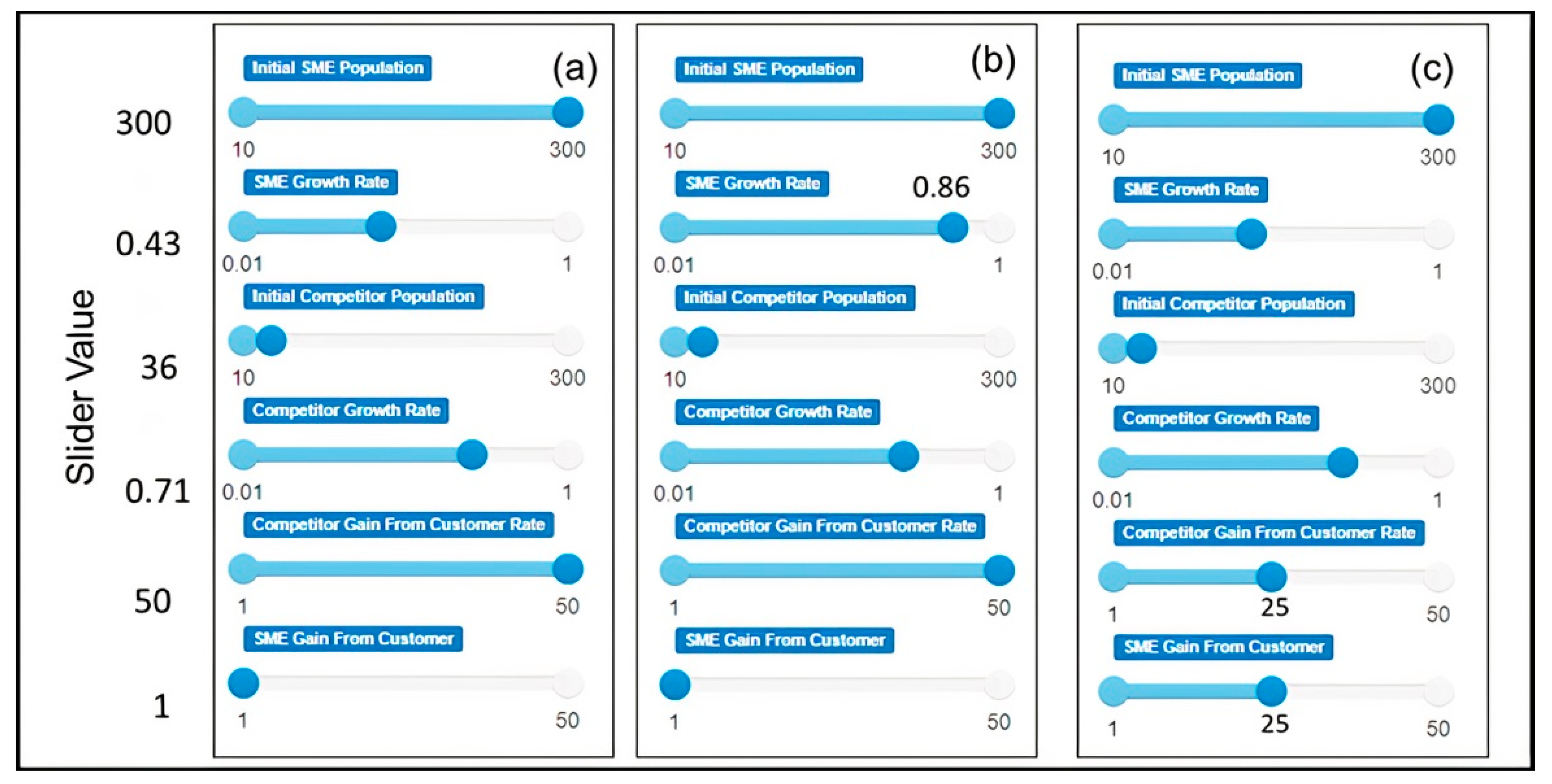

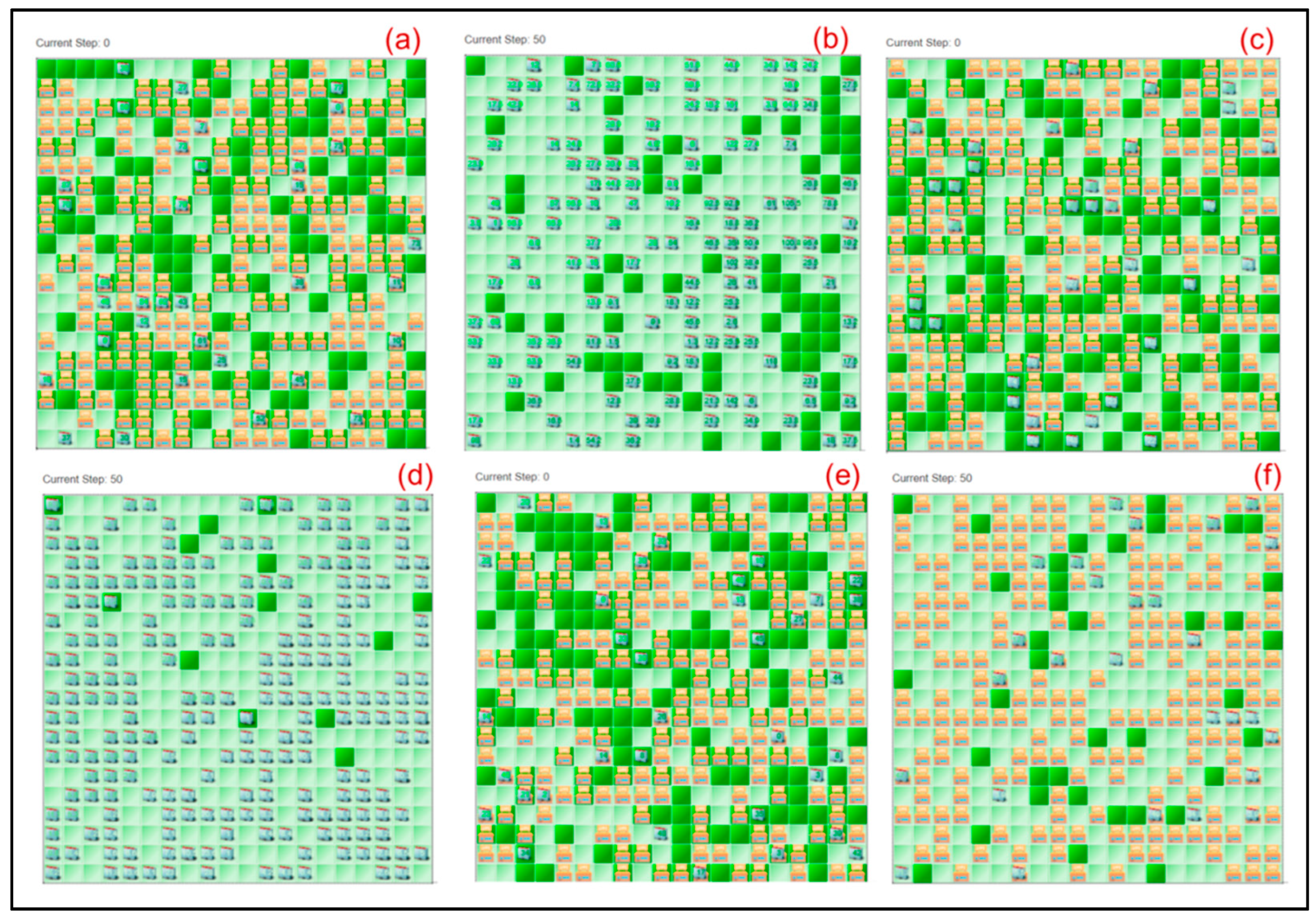


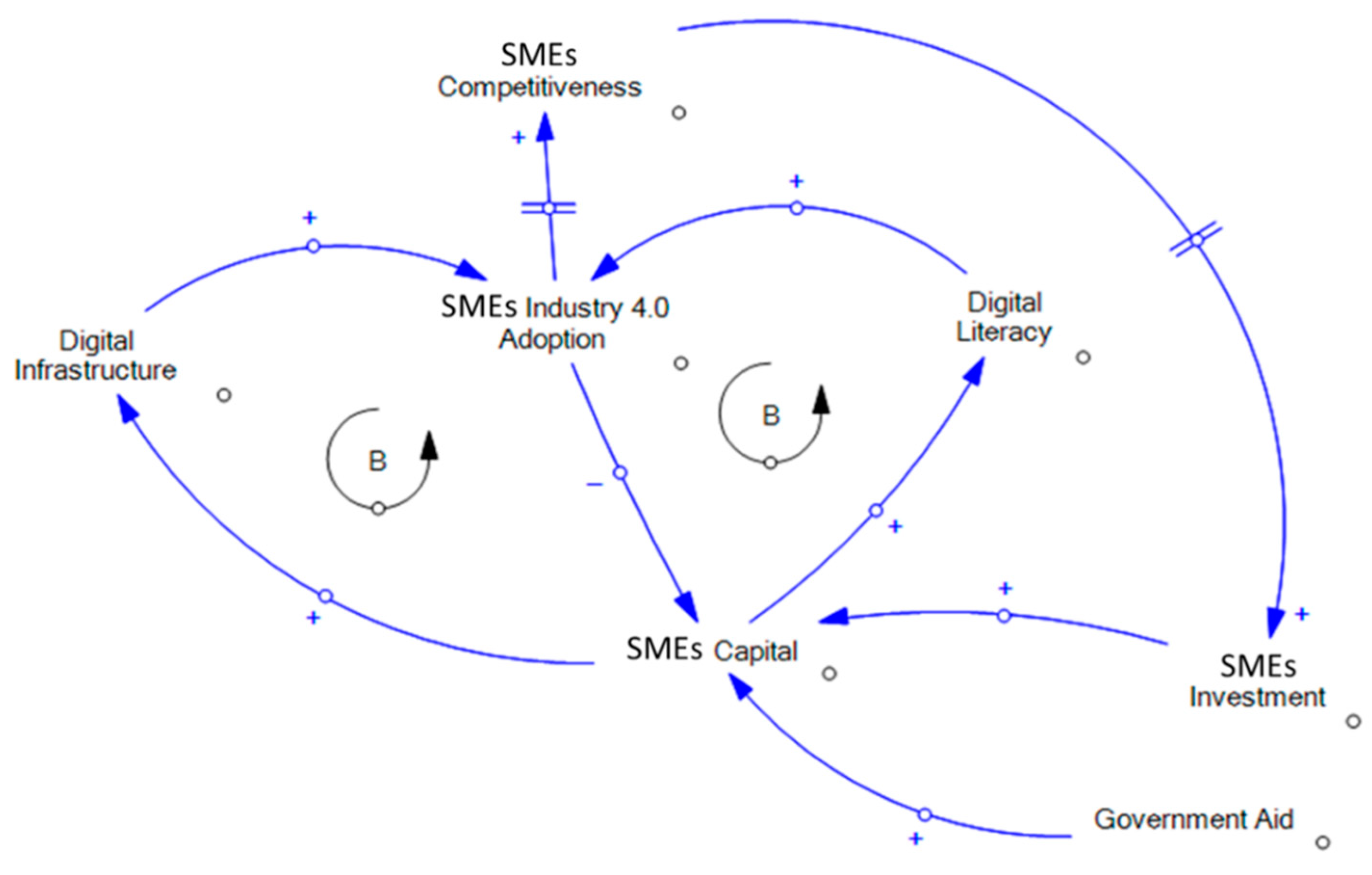

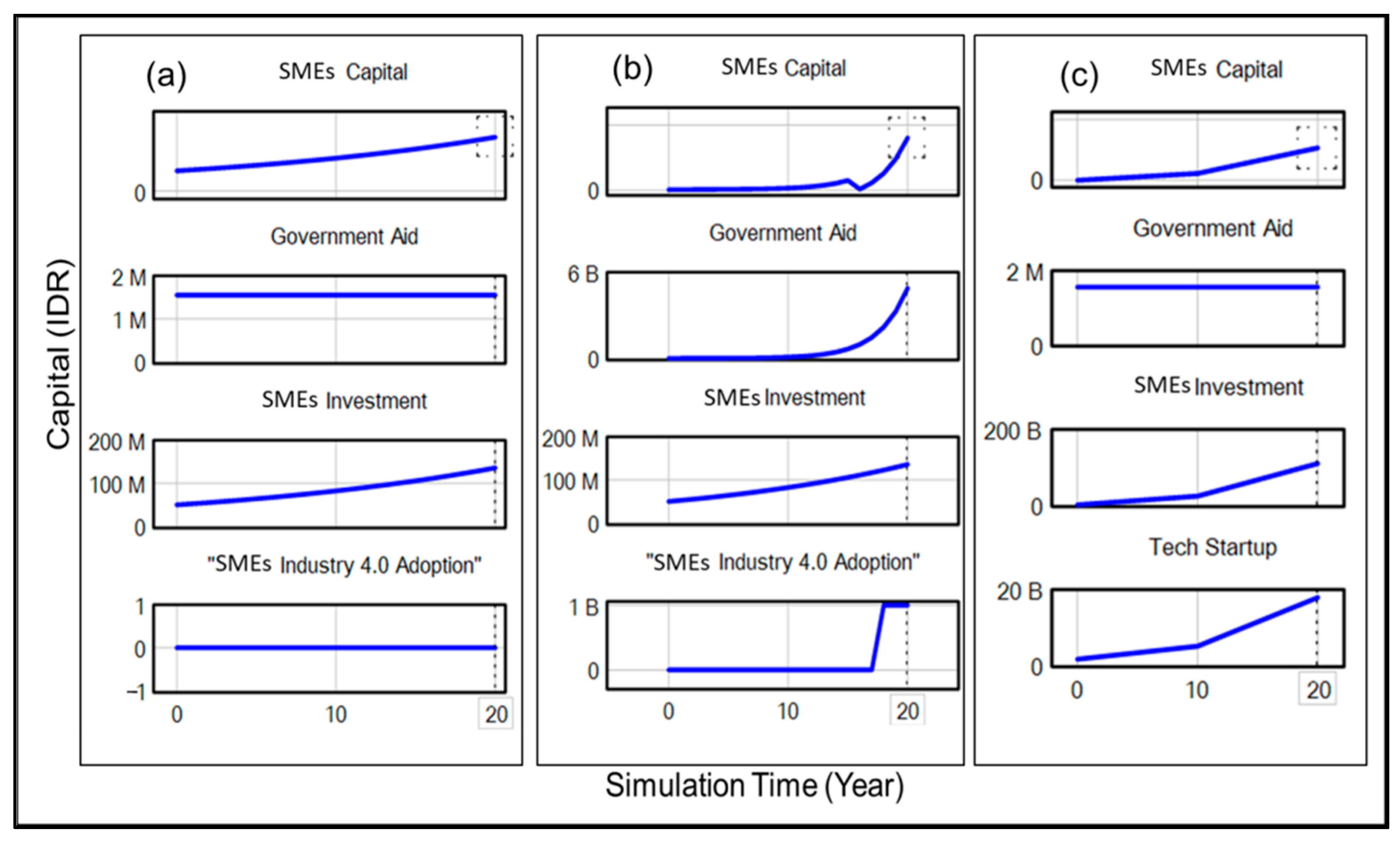
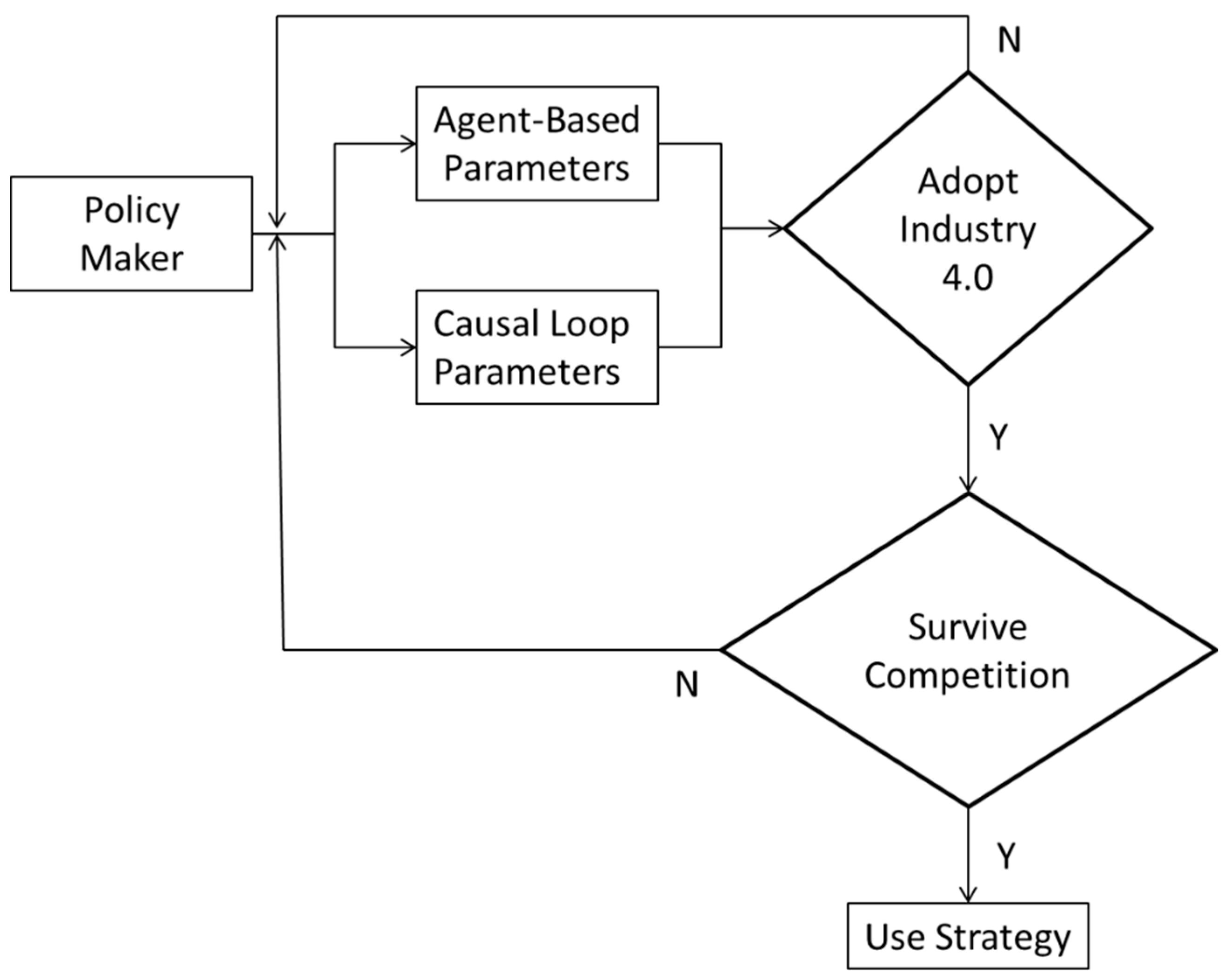
| Cost Component Equations | |
|---|---|
| Adoption Technology | Adoption Cost |
| High Speed Internet (HSI) | Equation (1) |
| Computing Server (CS) | Equation (2) |
| AI Technology (AI) | Equation (3) |
| IoT Technology (IoT) | Equation (4) |
| Software (Soft) | Equation (5) |
| Subscription Price Setting | |
| SC | Equation (6) |
| Initial SMEs System | |
| Variable | Simultaneous Equation |
| Government Aid | Equation (7) |
| SMEs Investment | Equation (8) |
| SMEs Capital | Equation (9) |
| Digital Literacy | Equation (10) |
| Digital Infrastructure | Equation (11) |
| SMEs Industry 4.0 Adoption | Equation (12) |
| SMEs Competitiveness | Equation (13) |
| SMEs with Tech. Startups System | |
| Technology Startup | Equation (14) |
| Venture Capital | Equation (15) |
| Angel Investors | Equation (16) |
Publisher’s Note: MDPI stays neutral with regard to jurisdictional claims in published maps and institutional affiliations. |
© 2022 by the authors. Licensee MDPI, Basel, Switzerland. This article is an open access article distributed under the terms and conditions of the Creative Commons Attribution (CC BY) license (https://creativecommons.org/licenses/by/4.0/).
Share and Cite
Tama, I.P.; Nugroho, W.S.; Mahmudy, W.F.; Purnami, P. The Evaluation of Technology Startup Role on Indonesian SMEs Industry 4.0 Adoption Using CLD-ABM Integrated Model. Sustainability 2022, 14, 8462. https://doi.org/10.3390/su14148462
Tama IP, Nugroho WS, Mahmudy WF, Purnami P. The Evaluation of Technology Startup Role on Indonesian SMEs Industry 4.0 Adoption Using CLD-ABM Integrated Model. Sustainability. 2022; 14(14):8462. https://doi.org/10.3390/su14148462
Chicago/Turabian StyleTama, Ishardita Pambudi, Willy Satrio Nugroho, Wayan Firdaus Mahmudy, and Purnami Purnami. 2022. "The Evaluation of Technology Startup Role on Indonesian SMEs Industry 4.0 Adoption Using CLD-ABM Integrated Model" Sustainability 14, no. 14: 8462. https://doi.org/10.3390/su14148462







